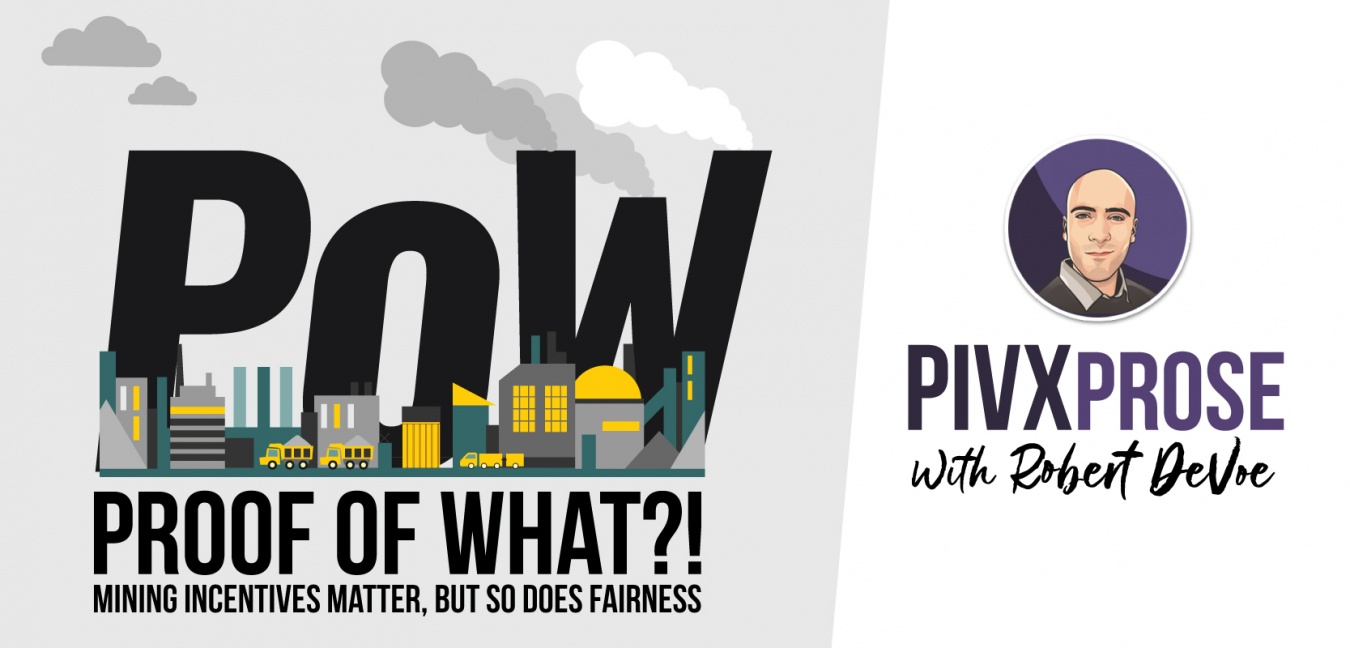
The problem with this, however, is obvious. Why would anyone choose to willingly commit their time, energy, or resources to something when they get nothing in return? For instance, if bitcoin mining yielded no rewards whatsoever, do you think anyone would do it? Perhaps an altruistic few would, but the support for that network would be nowhere near what it is today if it wasn’t potentially profitable. This is where we get into the fascinating domain of incentives.
Incentives, like mining rewards, are what make people commit to supporting a network. While bitcoin and other coins rely on proof-of-work mining, PIVX chose to take it in an entirely different direction by using proof-of-stake. This begs the question – what’s the best way to find a balance between incentivizing enough people to have a stable and secure network, and not making an uneven playing field where only the rich and powerful are able to benefit? To make things more complicated, how do you attract the rich and powerful who have far more resources than the rest of us, while not making it unfair for the less wealthy? This could be a long one, but this week’s edition of PIVX Prose is all about finding the right balance between incentives, fairness, and security.
Proof-of-Work Works (but Sucks)
Let’s face it, the bitcoin network (I’m talking BTC) has never successfully been hacked. I don’t mean that coins have never been stolen, I mean that the network itself has never suffered a direct attack that succeeded. Compare this to other, smaller projects that rely on proof-of-work that have successfully been attacked. My point is that under the right circumstances, proof-of-work can provide security and process a sufficient enough amount of transactions to make the network desirable.
However, as the subheading for this section suggests, we at PIVX think that proof-of-work sucks. If other projects or coins want to use it, good on them, but we decided to go in a different direction.
To explain why we made this decision, let’s go over the few of the reasons why proof-of-work is far from ideal. I could write a book on just the subject to proof-of-work, so I’m going to be glossing over a lot of details here. If you have any nitpicks you want to share, feel free to do so in the comments.
First, the biggest elephant in the room when addressing proof-of-work is that it is wasteful. Proof-of-work requires vast armies of high-intensity computing devices like ASIC miners cranking out billions upon billions of calculations per second across the globe in order to work. Not only that, but mining is competitive. That means miners are forced to continually upgrade and deploy more and more machines to stand any chance of winning the pot. This means that as time goes on, increasingly more copious amounts of energy are needed to support the network and for miners to remain competitive.
A lot could be said about the global banking industry and its energy consumption in comparison to bitcoin, but that’s not the main focus of our discussion today. Instead, we’re focusing on different forms of blockchain consensus models.
This hypercompetitive environment leads to a secondary problem. Smaller competitors such as individuals and hobbyists stand virtually no chance of ever being profitable outside of major boom cycles. That means unless prices are skyrocketing, individual and hobbyist miners will be lucky just to break even, let alone make a meager profit. So who is winning, then? That’s easy. Industrial-scale miners and the companies that control near-monopolies on ASIC mining devices (like Bitmain). These companies are the only ones that are able to purchase the machines in large enough quantities to benefit from economies of scale. This is doubly true of ASIC manufacturers themselves, as they are able to build the machines at cost and can recover this investment far easier than someone who is paying for the device at full retail price or higher. In short, it’s impossible for smaller players to compete. You’re either a massive behemoth that’s already wealthy beyond compare, or you need to GTFO.
With these first two issues in mind, a third concern then arises as a result of the first two. And that is, of course, centralization. If all of the hash rate is tied up amongst just a small handful of major players, these players can potentially threaten the network directly. This is especially ominous if we factor in that these major players might be forced to comply with local government laws that could be extremely anti-cryptocurrency.
Proof-of-Stake: A Better Alternative?
I won’t be able to delve deep into how proof-of-stake works here, but I’ll give you a very brief definition before we move on. In the simplest terms, proof-of-stake doesn’t use high-intensity, wasteful mining hardware. Instead, anyone with a consumer level computer can participate successfully and profitably. A user just has to buy and hold onto the coin in question and keep it in an online wallet. That wallet will help process transactions and secure the network in the background. Periodically, the person staking will receive rewards from the network in the same way that a bitcoin miner would when mining bitcoin. The catch is that there is a degree of chance involved. The more coins you hold in your wallet, the higher the chance that you will successfully stake.
The key advantage here is that anyone can participate in a proof-of-stake network. They don’t need to have vast armies of ASIC miners running 24 hours a day. Even using a 10-year-old computer, any coin holder can successfully stake and earn rewards. While it’s not a reality yet, PIVX even dreams of offering staking through mobile devices. My fingers are crossed that it becomes a reality someday.
That all sounds well and good, but some say PoS gives an advantage to the wealthy. But, let’s parse this out a bit. When you understand the math of it all, it offers the same percentage of reward for ALL stakers. Consider your savings account. The more money you have in your bank account, the more interest you get. That’s fair and reasonable. On the reverse side of this, if our tax systems taxed all with the same percentage, that could be fair as well.
Sadly, in the old money system, the rich gain wealth not only from interest on their money but from paying a lower percentage of taxes. With PIVX, the more coins you stake, the more chances you will have to earn rewards. You can think of it as a reusable lottery ticket. Each PIV you hold is a ticket that could win in every block reward which occurs once per minute. It makes sense then that the more tickets you keep, the more chances you have of winning each cycle.
Let’s look at this from another angle. If your odds of successfully staking were equal whether you had 1 PIV or 1 million PIV, why would anyone who wants to stake buy more than one? If everyone who wanted to stake only had to buy one PIV, this would negatively affect the demand for the coin and thus depress prices. Proof-of-stake naysayers will often argue that it unfairly favors the wealthy because of this structure.
We think, that the advantages gained in proof-of-stake by allowing effectively anyone to participate in staking and hold an equal chance per PIV held to win a block reward is worth it. Further, the initial investment cost to get started staking is just the cost of a single PIV. Compare that to mining bitcoin, where to stand any chance at all in earning any type of reward, one would need to purchase a multi-thousand dollar ASIC device and burn up their power bill like there was no tomorrow.
Finding a Balance
What does it take to draw in enough people to support the network, while not creating large degrees of inequality between the whales and the small fish?
First, we think that stakers or miners should be able to cover the costs of mining or staking, at the least. Simply put, they shouldn’t lose money by participating. Granted, crypto prices fluctuate often, we think that if they chose to, a miner or staker should be able to immediately sell their earned reward and be able to pay a proportional amount of their power bill as related to the activity.
Let’s do some calculations based on today’s prices. We won’t be factoring in start-up costs. Instead, we will be creating a level playing field where a hypothetical bitcoin miner purchases a state-of-the-art ASIC at full retail price and a PIVX staker buys and stakes an equal dollar value worth of PIV and converts them to zPIV.
Let’s suppose that you bought a brand-new Bitmain Antminer S15. Bitmain claims this device will retail for just over $1000. However, that doesn’t include a lot of other fees including international shipping, tax, and the very high likelihood that you’ll need to buy this from a third party since Bitmain devices typically sell out in minutes. We’re giving a conservative estimate that to get one of these devices, it would cost about $2000.
Assuming you pay the standard electric price of $0.10 per kilowatt hour, and that the block reward and difficulty remain similar to now, you could estimate to earn about $12.60 a month profit after paying electricity. Sounds pretty good, right?
Unfortunately, bitcoin mining devices like ASICs have a very short shelf life and become obsolete in a matter of months. That means you need to realize that whatever you paid for your ASIC is essentially a 100% loss. Therefore, in order to even begin making any actual profit, you’ll need to keep bringing in that $12.60 month until you reach $2000.
According to the bitcoin mining calculator coinwarz.com, at today’s numbers that would take approximately 13 years just to pay off your hardware costs. At the rate things are going you could never repay your hardware costs, because by the time you even begin to get close to repaying your hardware, difficulty will inevitably increase, and the block reward will likely cut in half again. Your only hope of ever recovering your initial investment is if bitcoin prices suddenly skyrocket. In other words, it’s a massive risk.
Now let’s suppose that you took that $2000 and put it entirely into PIVX with the intent to stake. At today’s PIV prices, that would net you about 2860 PIVX. If you were to convert all of those into zPIV for the highest reward and staked 24 hours a day, you could expect to earn just under $5 a month. That may not sound like much but remember that you have no upfront hardware costs for a device that will be completely obsolete in about 12 months. Additionally, your initial purchase of PIVX can be sold or traded at any moment (with no depreciation in the way that hardware depreciates).
In other words, if you ran your staking operation for 13 years, the same as the estimate to recover your initial investment of the bitcoin ASIC device, you would end up with a total profit of at least $613. You would end up with more as your PIV earnings would compound.
According to the calculator on whypivx.com, you could realistically expect to earn 84 PIV per year staking. If you chose not to sell or trade it and continued staking these new earnings, you would have close to 1092 additional PIV at the end of this timeline, and your monthly earnings would just about double. I’m oversimplifying this, obviously, but I think you understand my point.
Let’s be Realistic
PIVX has benefited from its active community for several years now. But let’s be honest with ourselves – we aren’t interested in PIVX only because we believe in it as though it were a religion. We participate in the network by staking or running masternodes because we think that the project has a future and that it’s increased use over time will make the network as a whole more valuable. That’s why it’s important to step back from the enthusiasm and excitement of our lively community and remember that PIVX could be a way to build our wealth and savings over time.
On the flipside, if you’re planning on buying PIVX to get rich quick, you’re likely to be disappointed. This is just my opinion, but I personally believe that we’re looking at a much longer timescale until the next boom cycle hits us. I would take that with a grain of salt, however, as I am of course not privy to know what the future holds. (Read: This is not financial advice!)
Proof-of-stake is not perfect, but that’s totally fine with us. We didn’t just adopt that consensus model and leave it. We’ve been developing and innovating and making it better. That’s why it’s now possible to stake zPIV and earn a more substantial reward. Minting and handling zPIV requires a bit more care and attention, that’s why we believe that those who get involved in zPIV deserve a more significant piece of the pie. I don’t believe that we’ll be stopping there, either. There is still a lot more room to grow when it comes to the ability of our users to engage in anonymous staking. And wherever the future takes us, I would bet that PIVX will be at the forefront, blazing a trail into the next big step towards wherever the technology and community will eventually lead us.
What’s your take? Is proof-of-work really all that bad? What do you think the next big development for PIVX and proof-of-stake is? Let us know in the comments, our Discord server, or on our sub-Reddit.






